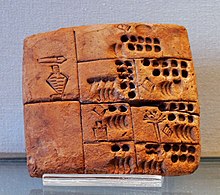

Kushim (Sumerian: 𒆪𒋆 KU.ŠIM; fl. c. 3200 BC) is supposedly the earliest known recorded name of a person in writing. The name "Kushim" is found on several Uruk period (c. 3400–3000 BC) clay tablets used to record transactions of barley. It is uncertain if the name refers to an individual, a generic title of an officeholder, or an institution.
Uruk period tablets
Writing in ancient Sumer was a time-consuming activity known to few. For this reason, writing was mainly used to keep necessary economic records. Literacy in Uruk was also likely limited at the time. A clay tablet detailing a trade transaction contains one of the first examples of rebus writing. It reads "28,086 measures barley 37 months Kushim." This may be interpreted as having been signed by "Kushim." As of 1993, Kushim's name was known to appear in 18 separate Proto-cuneiform clay tablets from the period.
Another Uruk period clay tablet that featured names dating back to around 3100 BC includes the names of a slave owner (Gal-Sal) and Gal-Sal's two slaves (En-pap X and the woman Sukkalgir). This tablet was likely produced one or two generations after the Kushim Tablet.
Identity
Kushim is believed to have been either an individual or a generic title of an officeholder. The cuneiform characters "KU" and "ŠIM" were not presented with much context, and therefore it is difficult to determine whether such sign combinations denote a person, the person's office, or an entire institution. Kushim was responsible for the production and storage of barley. Some of the tablets charge the distribution of barley to several officials as various debits, with the summation on the reverse as a single credit for the discharge of Kushim's liability. One relatively simple account shows the charging of various amounts of barley to three officials on the obverse, while Kushim was credited for the total amount distributed to the officials on the reverse. However, the reverse could also be interpreted as Kushim's account. Other tablets are more intricate, showing the input of various ingredients on the obverse (malt, dates, etc.), while showing different kinds of beer as output on the reverse side. One tablet shows Kushim providing 14,712 liters of barley to four officials, for which they were properly discharged.
See also
- History of accounting
- Iry-Hor, earliest historical figure known by name
- List of oldest documents
References
- ^ Harari, Yuval Noah (2014). "Signed, Kushim". Sapiens: A Brief History of Humankind (Signal paperback ed.). Penguin Random House Canada. p. 123. ISBN 978-0-7710-8351-8.
- "The Kushim Tablet". The Birth of Writing. Written Word. Falls Church, VA: Landmark Media Inc. 2005. OCLC 71846562.
- ^ Nissen, Hans Jörg; Damerow, Peter; Englund, Robert K. (1993). "The Administrative Activities of Kushim". Archaic Bookkeeping: Early Writing and Techniques of Economic Administration in the Ancient Near East. Translated by Larsen, Paul. University of Chicago Press. p. 36. ISBN 0-226-58659-6.
- Badenhorst, Francois (2015-08-20). "Meet Kushim, the accountant from ancient Sumer". Accountingweb.org.
- ^ Mattessich, Richard (2000). The Beginnings of Accounting and Accounting Thought: Accounting Practice in the Middle East (8000 BC to 2000 BC) and Accounting Thought in India. Garland Publishing. pp. 105–106. ISBN 0-8153-3445-1.
- Mattessich, Richard, "Recent insights into mesopotamian accounting of the 3rd millennium B.C.-successor to token accounting", The Accounting Historians Journal, vol. 25, no. 1, pp. 1–27, 1998
- Krulwich, Robert (2015-08-19). "Who's the First Person in History Whose Name We Know?". National Geographic. Archived from the original on July 7, 2018.
Notes
- Some sources give it as 29,086 measures, however this is likely a transcription error since when the symbols are calculated, it comes out as 28,086 measures, approximately 135,000 litres
External links
- MS 1717: Beer production at the Inanna Temple in Uruk in the Schøyen Collection
- MSVO 3, 29 at the Cuneiform Digital Library Initiative
- Tablets containing Kushim at the Cuneiform Digital Library Initiative
- What was the first (known) maths mistake?, video by Matt Parker
- A photograph of a tablet containing Kushim